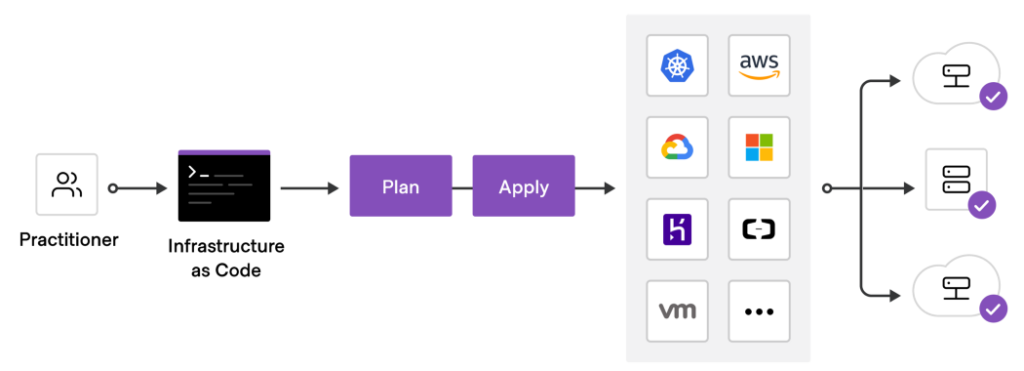Mastering best practices for Terraform engineers is crucial for optimizing infrastructure automation and driving CI/CD success. From effective state management to seamless Terraform CI/CD integration, these techniques reduce the risk of errors and enhance your DevOps team’s efficiency.
Terraform engineers reign supreme in infrastructure as code (IaC). This article delves into the essential best practices for Terraform engineering, empowering you to build a team of IaC rockstars.
[ez-toc]
Quick Intro to Terraform

From effective state management to seamless Terraform CI/CD integration, these techniques reduce the risk of errors and enhance your DevOps team’s efficiency. Photo by Marília Castelli .
5 Best Practices for Terraform Engineering
Consider both short-term needs and long-term goals when defining your Terraform strategy. While specific cloud platforms may be in focus initially, future expansion might necessitate expertise in multiple cloud environments.
It’s also worth menioning that machine learning integration can enhance Terraform capabilities by allowing dynamic infrastructure automation based on real-time data for meeting resource requirements.

Backend Engineers enhance functionality and power server-side logic and databases, ensuring that data and requests flow seamlessly.
Integration with CI/CD Pipelines
Effective development and operations teams leverage Terraform CI/CD integration to reduce the risk of deployment errors and achieve continuous improvement.
The synergy between Terraform and CI/CD pipelines is essential for achieving continuous delivery. Terraform engineers should focus on integrating Terraform into existing CI/CD workflows to automate infrastructure provisioning and configuration management.
Infrastructure as Code Best Practices
Adhering to IaC best practices is paramount for successful Terraform implementation. This includes:
- Modularity: Breaking down infrastructure into reusable modules for efficient management.
- Testing: Writing comprehensive tests for Terraform configurations to ensure reliability.
- Version Control: Utilizing Git or other version control systems to track changes and collaborate effectively.
- Security: Implementing robust security measures to protect infrastructure resources.
Terraform Module Best Practices
Over the next few sections, we provide a detailed and actionable guide for Terraform engineers, helping them excel in infrastructure automation and CI/CD integration while following best practices.
What are Terraform Modules?
Terraform modules are essential building blocks in IaC. They allow engineers to encapsulate configurations into reusable, self-contained packages that define specific infrastructure components—whether it’s networks, virtual machines, or storage.
Terraform engineers leverage modules to ensure that their infrastructure definitions are consistent, reusable, and scalable across different projects.
5 Best Practices for Module Design

Traditional on-premise infrastructure can’t keep pace with the explosive growth experienced by many software companies. Photo by fran innocenti
Infrastructure Automation with Terraform
What is Infrastructure Automation?
Infrastructure automation refers to the process of using tools like Terraform to automate the provisioning, management, and configuration of infrastructure. This approach eliminates manual intervention, reduces the likelihood of errors, and accelerates deployment processes.

Terraform’s state allows you to track resource changes, and safely update and manage infrastructure on AWS, GCP, and Azure, automatically.
4 Key Practices for Automation
Terraform State Management
What is Terraform State?
Terraform uses a state file to keep track of the current state of your infrastructure. This file acts as a source of truth, enabling Terraform to determine what changes need to be applied to bring the infrastructure in line with the desired state defined in your configurations.
4 Best Practices for State Management

By mastering CI/CD pipelines, DevOps engineers leverage automation tools and infrastructure as code (IaC) to enhance project management and deliver high-quality software efficiently. Photo by Waddas Magalhães.
Terraform CI/CD Integration
Why Integrate Terraform with CI/CD?
CI/CD (Continuous Integration and Continuous Delivery) is a fundamental practice in modern software development. Integrating Terraform with CI/CD pipelines enables automated and consistent deployment of infrastructure changes, ensuring that infrastructure evolves alongside application code.
4 Best Practices for CI/CD Integration
Building a High-Performance Terraform Team
When writing a Terraform job description, focus on technical skills like infrastructure automation and cloud infrastructure expertise. Hire a Terraform engineer with expertise in Terraform module best practices and CI/CD integration to build a high-performing team.
Hiring a Terraform engineer requires a strategic approach. Ubiminds can help you find the perfect fit. We specialize in staff augmentation, connecting you with top Terraform talent. Our candidates possess not only the technical skills needed to excel but also the devops mindset and collaborative spirit to drive your organization forward.

Having the right people may affect your decisions on how to deliver quality software faster
5 Skills Terraform Engineers Should Master
Is Terraform a good skill? Absolutely! The demand for skilled Terraform engineers is soaring. According to Indeed, Terraform engineer salaries in the US average over $120,000 annually. Terraform expertise empowers engineers to automate critical tasks, optimize cloud infrastructure, and drive operational efficiency.
So, what makes a best-in-class Terraform engineer? More than just technical skills are required. Here’s the blueprint for success:
A skilled Terraform engineer possesses a blend of technical expertise and problem-solving abilities. Essential competencies include:
Core Competencies of a Terraform Engineer
- Infrastructure as Code (IaC) Mastery: A deep understanding of IaC principles and the ability to translate infrastructure requirements into Terraform code.
- Cloud Platforms: Proficiency in at least one major cloud platform (AWS, Azure, GCP) and their corresponding Terraform providers.
- Scripting Languages: Knowledge of scripting languages (Python, Bash, Ruby) for automating tasks and integrating Terraform into CI/CD pipelines.
- Version Control: Proficiency in Git or other version control systems for managing Terraform code.
- Networking: Understanding of networking concepts (subnets, routing, security groups) is essential for effective infrastructure provisioning.
- Security: A strong focus on security best practices to protect infrastructure resources.
Best Practices for Terraform Engineering
- Modularity: Create reusable Terraform modules to promote code reusability and maintainability.
- State Management: Effectively manage Terraform state to prevent conflicts and ensure consistency.
- Testing: Implement unit and integration tests for Terraform code to catch errors early.
- Collaboration: Work closely with DevOps teams to align infrastructure provisioning with application development.
- Continuous Improvement: Stay updated with the latest Terraform features and best practices.
Advanced Terraform Techniques
- Terraform Cloud: Leverage cloud-based Terraform services for collaboration, state management, and advanced features.
- Terraform Modules Registry: Utilize public or private module registries to share and reuse Terraform modules.
- Infrastructure as Code Security Best Practices: Implement security controls and vulnerability scanning.
- Terraform Drift Detection: Monitor infrastructure for changes and automatically remediate deviations.
Where to Hire Terraform Engineers to Accelerate Infrastructure Provisioning
Brazil’s growing tech ecosystem offers a skilled workforce, making it a strategic location for staff augmentation in Terraform engineering. If you’re looking to streamline your infrastructure provisioning and management, consider tapping into this talent pool.

Hiring DevOps Engineers and SREs starts with looking for technical skills and experience, but is ultimately about alignment with your project goals.
Why Hire Terraform Engineers in Brazil?
- Cost-effective: Leverage competitive labor costs without compromising on quality.
- Strong technical skills: Brazilian engineers possess a solid foundation in Terraform and infrastructure as code.
- Growing cloud adoption: Brazil’s increasing cloud adoption has fostered a skilled workforce in infrastructure automation.
Key Considerations for Hiring Terraform Engineers in Brazil
- Language proficiency: Assess English language skills to ensure effective communication and collaboration.
- Time zone differences: Consider how time zone differences might impact project management.
- Legal and tax implications: Understand the legal and tax requirements for hiring employees or contractors in Brazil.
Ubiminds takes care of all of that for you, so you don’t have to worry about any of it. The effort, overhead cost, and liability is on us.
Finding and Hiring Terraform Engineers in Brazil
- Leverage online platforms: Utilize job boards, professional networking sites, and freelance platforms to find qualified candidates.
- Partner with local recruitment agencies: Tap into the expertise of Brazilian recruitment firms.
- Build a strong employer brand: Attract top Terraform talent by showcasing your company’s commitment to cloud infrastructure and DevOps.
By carefully considering these factors and implementing effective recruitment strategies, you can build a high-performing infrastructure team in Brazil.
The Future of Terraform Engineering: A Brave New World
The Terraform landscape is rapidly evolving, with new challenges and opportunities emerging. To stay ahead, Terraform engineers must adapt to these changes and embrace emerging trends.
The Rise of Multi-Cloud and Hybrid Environments
As organizations adopt multi-cloud and hybrid cloud strategies, Terraform engineers will need to expand their expertise across different cloud platforms. While Terraform supports multiple providers, mastering the nuances of each platform is crucial for effective infrastructure management.
4 Emerging Trends in Terraform
#1 Terraform Cloud: Leveraging cloud-based Terraform services for collaboration and automation.
#2 Terraform Modules: Utilizing pre-built modules to accelerate infrastructure provisioning.
#3 Terraform Drift Detection: Monitoring infrastructure for changes and automatically reapplying desired state.
#4 Infrastructure as Code Security: Implementing security best practices within Terraform configurations.
The Role of Terraform Engineers in the Future
As infrastructure becomes increasingly complex, the role of Terraform engineers will evolve. They will need to:
- Collaborate closely with other DevOps roles: Work in tandem with developers, operations, and security teams.
- Embrace new technologies: Stay updated on emerging IaC tools and practices.
- Focus on automation: Automate repetitive tasks to improve efficiency and reduce errors.
- Drive innovation: Contribute to the development of new infrastructure provisioning strategies.
Terraform engineers are at the forefront of infrastructure automation. By understanding the core principles, best practices, and emerging trends, you can build a high-performing Terraform team capable of delivering exceptional results.
Ubiminds specializes in finding top-tier Terraform engineers who can propel your organization forward. Let us help you build a world-class infrastructure team. Contact Ubiminds today to find your next Terraform expert.

International Marketing Leader, specialized in tech. Proud to have built marketing and business generation structures for some of the fastest-growing SaaS companies on both sides of the Atlantic (UK, DACH, Iberia, LatAm, and NorthAm). Big fan of motherhood, world music, marketing, and backpacking. A little bit nerdy too!



